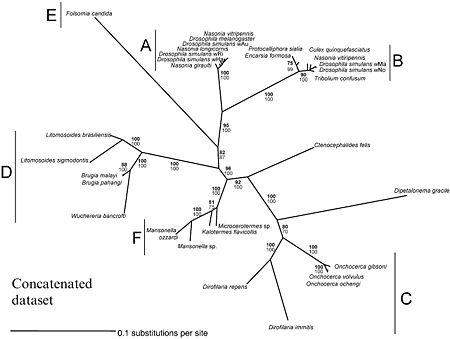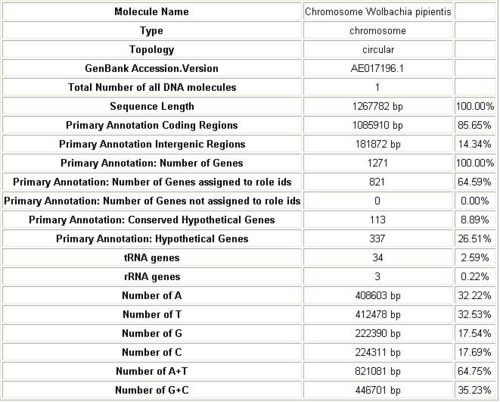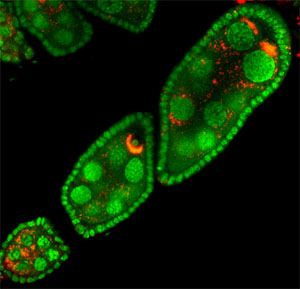Wolbachia pipientis
A Microbial Biorealm page on the genus Wolbachia pipientis

Classification
Higher Order Taxa
Bacteria; Proteobacteria; Alphaproteobacteria; Rickettsiales; Rickettsiaceae; Wolbachieae; Wolbachia
Genus and Species
Wolbachia pipientis
|
NCBI: Taxonomy Genome: - Wolbachia pipientis wMel |
Description and Significance
Wolbachia pipientis are bacteria that infect a wide range of invertebrate, mainly arthropods and numerous insects. Wolbachia is one of the most common pathogens on Earth that infect the reproductive system of insects; it is estimated that more than 18% of insects are infected by it including spider, mosquito, and flies. The bacteria give various physical characteristics of its infection that cause a variety of result including deterring chromosomal sex determination from gamete fertilization. Also, it may initiate parthenogenesis that causes growth and development without fertilization by sperm because it can selectively kill males; thus, it creates a detrimental competition against sperm and causes cytoplasmic incompatibility in fertilized eggs. Wolbachia's uniqueness in altering reproduction has caused many scientists to research the biology of infection and their potential use for controlling pest and pathosis.
Genome Structure
From further observation of the genomic structure has unfolded the many mysteries of biology and evolution of the bacteria. For instance, orthologous genes that are unique from bacteria of the same genus show a similar pattern among the bacteria that originate from the same ancestor. Different species of the same genus have closely related DNA sequences with the same repetitiveness and mobile elements. According to a research, this observation, in conjunction with evolutionary dogma, gives an impression that natural selection may somehow ineffective because of population bottleneck.
Furthermore, the chromosome of Wolbachia appears to be circular just like many other bacteria with about 1.3mbp. Of the sequence, about 1mbp are the primary coding region. The number of genes are estimated to be around 800 with 34 tRNA genes and 3 rRNA genes. The number of A+T nucleotides base pairing is estimated 65% while the number of G+C nucleotides base pairing is 35%.
Cell Structure and Metabolism
Wolbachia is a gram-negative bacteria. In these bacteria, the cell wall contains fewer layer of peptidoglycan than gram-positive bacteria. So, the structure of the outer membrane contains porins that help to transfer molecules, and lipopolysaccharide that contains Lipid A, core polysaccharide, and O-polysaccharide. Furthermore, lipoproteins are attached to the polysaccharide backbone.
Another analysis to the genomes, shows a pattern of paralogous genes which have similar function, but often times not because the copy of the duplicated gene is less practical; this copy is free to mutate and acquire new functions. Unlike the metabolic activity of a closely related Rickettsia that is able to generate ATP from their hosts, Wolbachia use glycolysis and purine synthesis. Another observation includes the lack of lipopolysaccharide synthesis in Wolbachia.
Ecology
Based on many studies, the evidence of vertical gene transfer in their hosts by Wolbachia is apparent. However, there’s no proof that supports any lateral gene transfer between Wolbachia and D. melanogaster or between Wolbachia and any other hosts. Furthermore, evolutionary evidence shows that mitochondria share a common ancestor with alpha-Proteobacteria, but has no evidence for similarity with mitochondria with species in the order of Rickettsiales.
Pathology
Wolbachia is a parasitic bacteria that infects reproductive system of insects which ultimately affects their linage continuation. The symbiosis between the bacteria and host is complex. Depending on the interaction, it ranges from mutualism to parasitism. The bacteria infect different types of organ, but the remarkable characteristic is their ability to alter the way maternal genes are passed on to the next generation by infecting the testes and ovaries of their hosts. There are four different phenotypes expressed:
- male killing (death of infected males). This selectively allows females to survive and more likely to reproduce even in the absence of males.
- feminization (infected males grow as either fully fertile females or infertile pseudo-females)
- parthenogenesis(reproduction of infected females asexually)
- Cytoplasmic incompatibility (the inability of Wolbachia-infected males to successfully reproduce with uninfected females). This method causes a certain Wolbachia strain to be more dominant over the others.
Furthermore, Wolbachia are not found in mature sperms, but are found in mature eggs. So, the infection is carried along to offspring by infected females but not males.
Application to Biotechnology
Currently, there's no known compound or enzyme identified for biotechnological use.
Current Research
- The bacteria were first identified in 1924 by Hertig and Wolbach in Culex pipiens, a species of mosquito
- Research by Sullivan uncovers modus operandi of parasitic bacterium in insects
- Interaction of Drosophila and its endosymbiont Wolbachia: natural heat shock and the overcoming of sexual incompatibility
- Using Wolbachia to reduce virus transmission: Toward the genetic manipulation of crop pests
References
Description and Significance:
Genome Structure
Pathology
Current Research
- M. Hertig & S. B. Wolbach (1924). "Studies on Rickettsia-like microorganisms in insects". Journal of Medical Research 44: 329–374
- Research by Sullivan
- Interaction of Drosophila and its endosymbiont Wolbachia
- Using Wolbachia to reduce virus transmission


